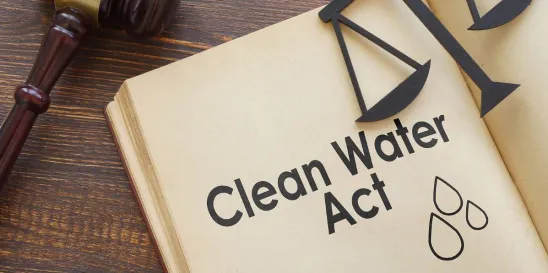When EPA published its most recent rule specifying the role of States and Tribes in the Federal permitting of discharges into Waters of the United States, I predicted it was only a matter of time before we'd see another federal lawsuit against EPA by “red” states and industry groups seeking to overturn the rule.
Well the rule was effective a few weeks ago and this week 11 of our nominally United States and industry “co-plaintiffs”, including the American Petroleum Institute, the Interstate Natural Gas Association of America, and the National Hydropower Association, have sued to overturn the rule.
I think EPA could have more Clean Water Act problems with the nation's highest court if this litigation gets that far.
By way of context, Section 401 of the Clean Water Act requires that States and Tribes have the opportunity to certify their acceptance of activities that may result in a "discharge" into a "Water of the United States" before the Federal government issues a permit or license authorizing those activities. That certification can specify enforceable conditions beyond those the Federal Government might impose.
Examples of activities requiring such certifications include dredging, the generation of hydroelectricity, and discharges of "pollutants" authorized by NPDES permits, including construction permits.
During the Trump Administration EPA made it harder for States and Tribes to flex their section 401 muscles.
And, as a result of the Supreme Court's decision in Sackett v. EPA earlier this year, there are fewer “Waters of the United States” than there had been for decades prior.
But the Biden Administration EPA certainly isn't going gently into that good night. It was already litigating with half of the states over its Waters of the United States rule in response to Sackett and now it is going to be litigating over its Section 401 rule.
It isn't at all surprising that EPA finds itself in this position.
EPA says States and Tribes can prevent the issuance of a Federal permit of a “discharge” to a Waters of the United States if a State or Tribe concludes that the “activity” associated with the discharge will have adverse impacts on water quality whether or not the waters impacted are Waters of the United States.
In other words, EPA is saying that a State or Tribe can effectively prohibit an activity under the Federal Clean Water Act that the Federal Government could not prohibit under the same Act. It had to know it was going to have a fight over that. And, as if that wasn't provocative enough, EPA's rule also specifically allows for the possibility that the state and tribal laws that a State or Tribe can consider in determining whether or not to provide a certification can include state and tribal laws regarding water quality other than relating to the quality of Waters of the United States.
On the one hand, that may very well be the best thing for human health and the environment, especially given the fact that the Federal Government's Clean Water Act jurisdiction is now narrower than it has been in a generation.
On the other hand, based on what Justice Alito, writing for a solid majority of the Supreme Court, had to say in Sackett v. EPA about Congress’s intent in passing the Clean Water Act, I think it likely that same Sackett majority will have trouble with EPA’s suggestion that the Clean Water Act allows for this exercise of “cooperative federalism”.
Apparently the Plaintiffs in the Louisiana litigation are thinking the same thing.
One more thing – the prior EPA rule resulted in considerable delays of important projects, including critically important infrastructure and renewable energy projects, because of the time it took States to issue Section 401 Water Quality Certifications when it issued them at all. That has human health and environmental impacts too. And the now challenged role made only marginal improvements on that score.
But, the complaint continues that the 2023 rule “abandons the statute’s focus on the ‘discharge,’ and instead requires certifying authorities to undertake a broad scope of certification review that encompasses the entire activity subject to the Federal license or permit.” By broadening the scope of certification review to “activity,” the plaintiffs charge, EPA’s rule “unlawfully expands the scope of waters and types of discharges to which the CWA applies.” For example, the rule requires the certifying authority to evaluate the activity’s construction and operation -- even though the operation may be subject to a different federal license or permit. It also allows the certifying authority to address adverse impacts contributed to by a federally licensed or permitted activity, not just the adverse water quality impacts caused exclusively by the activity.




 />i
/>i

